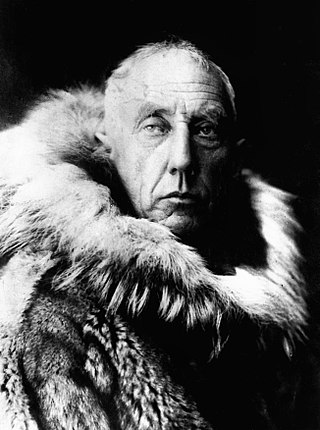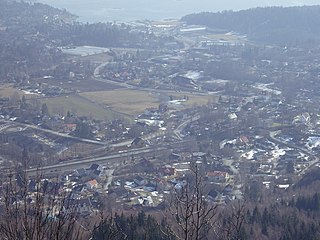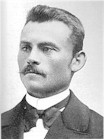
Roald Engelbregt Gravning Amundsen was a Norwegian explorer of polar regions. He was a key figure of the period known as the Heroic Age of Antarctic Exploration.

Asker, also called Asker proper, is a district and former municipality in Akershus, Norway. From 2020 it is part of the larger administrative municipality Asker together with the traditional Buskerud districts Røyken and Hurum; Asker proper constitutes the northern fourth and is part of the Greater Oslo Region. The administrative centre was the town of Asker, which remains so for the new larger municipality. Asker was established as a parish in the Middle Ages and as a municipality on 1 January 1838.

Fram ("Forward") is a ship that was used in expeditions of the Arctic and Antarctic regions by the Norwegian explorers Fridtjof Nansen, Otto Sverdrup, Oscar Wisting, and Roald Amundsen between 1893 and 1912. It was designed and built by the Scottish-Norwegian shipwright Colin Archer for Fridtjof Nansen's 1893 Arctic expedition in which the plan was to freeze Fram into the Arctic ice sheet and float with it over the North Pole.

Cambridge Bay is a hamlet located on Victoria Island in the Kitikmeot Region of Nunavut, Canada. It is the largest settlement on Victoria Island. Cambridge Bay is named for Prince Adolphus, Duke of Cambridge, while the traditional Inuinnaqtun name for the area is Ikaluktutiak or Iqaluktuuttiaq meaning "good fishing place".

Henry Asbjørn Larsen was a Norwegian-Canadian Arctic explorer. Larsen was born on a small island, Herføl, south of Fredrikstad in Norway. Like his hero, Roald Amundsen, he became a seaman. Larsen immigrated to Canada, and became a British subject in 1927. In 1928, he joined the Royal Canadian Mounted Police (RCMP).

The Axel Heiberg Glacier in Antarctica is a valley glacier, 30 nautical miles long, descending from the high elevations of the Antarctic Plateau into the Ross Ice Shelf between the Herbert Range and Mount Don Pedro Christophersen in the Queen Maud Mountains.

Oscar Adolf Wisting was a Norwegian Naval officer and polar explorer. Together with Roald Amundsen he was the first person to reach both the North and South Poles.

Helmer Julius Hanssen was a Norwegian sailor, pilot and polar explorer. He participated in three of the polar expeditions led by Roald Amundsen and was one of the first five explorers to reach the South Pole.

Sverre Helge Hassel was a Norwegian polar explorer and one of the first five people to reach the South Pole.

Gjøa was the first vessel to transit the Northwest Passage. With a crew of six, Roald Amundsen traversed the passage in a three-year journey, finishing in 1906.

Terra Nova was a whaler and polar expedition ship. The ship is best known for carrying the 1910 British Antarctic Expedition, Robert Falcon Scott's last expedition.
Vollen is a part of the Asker municipality in Akershus county, Norway. For statistical purposes, it is usually treated as part of the Oslo urban area. It is mainly a residential area, though the area has a café, a restaurant, several art galleries, a primary school and secondary school.

The research ship had origins in the early voyages of exploration. By the time of James Cook's Endeavour, the essentials of what today we would call a research ship are clearly apparent. In 1766, the Royal Society hired Cook to travel to the Pacific Ocean to observe and record the transit of Venus across the Sun. The Endeavour was a sturdy boat, well designed and equipped for the ordeals she would face, and fitted out with facilities for her research personnel, Joseph Banks. And, as is common with contemporary research vessels, Endeavour carried out more than one kind of research, including comprehensive hydrographic survey work.

The first ever expedition to reach the Geographic South Pole was led by the Norwegian explorer Roald Amundsen. Himself and four other crew members made it to the geographical south pole on 14 December 1911, which would prove to be five weeks ahead of the competetive British party led by Robert Falcon Scott as part of the Terra Nova Expedition. Amundsen and his team returned safely to their base, and about a year later heard that Scott and his four companions had perished on their return journey.

The Fram Museum is a museum telling the story of Norwegian polar exploration. It is located on the peninsula of Bygdøy in Oslo, Norway.

Nansen's Fram expedition of 1893–1896 was an attempt by the Norwegian explorer Fridtjof Nansen to reach the geographical North Pole by harnessing the natural east–west current of the Arctic Ocean. In the face of much discouragement from other polar explorers, Nansen took his ship Fram to the New Siberian Islands in the eastern Arctic Ocean, froze her into the pack ice, and waited for the drift to carry her towards the pole. Impatient with the slow speed and erratic character of the drift, after 18 months Nansen and a chosen companion, Hjalmar Johansen, left the ship with a team of Samoyed dogs and sledges and made for the pole. They did not reach it, but they achieved a record Farthest North latitude of 86°13.6′N before a long retreat over ice and water to reach safety in Franz Josef Land. Meanwhile, Fram continued to drift westward, finally emerging in the North Atlantic Ocean.
Jan Wanggaard is a Norwegian artist with a wide range of expressions from pure sculpture to land art in a wide sense. He was World Champion in windsurfing in 1981 and studied Art and Design in Newcastle upon Tyne, England (1983–1987).

Andreas Beck was a Norwegian seal-hunter, polar captain, ice captain, and shipowner.

The bark Danmark is best known for her role as expedition ship for the Danmark expedition (1906–08), so named after the ship, but had a long prehistory as a whaler under the name Sir Colin Campbell of Peterhead and later as a sealer named Magdalena of Tønsberg/Kristiana.























